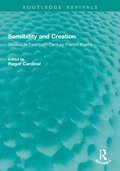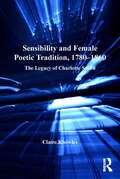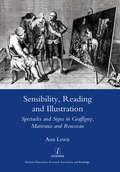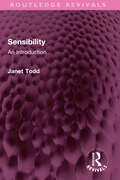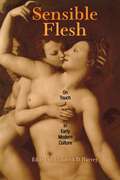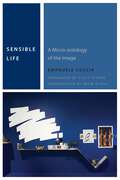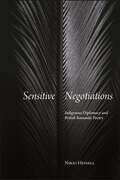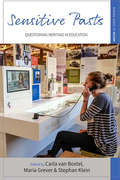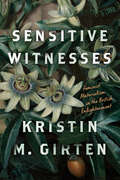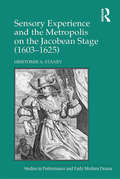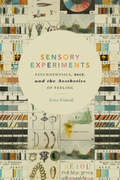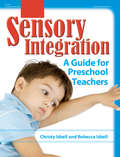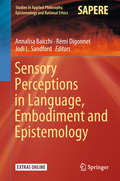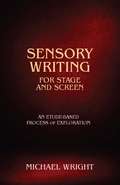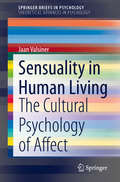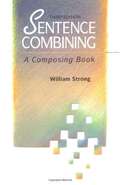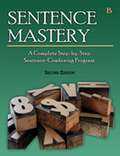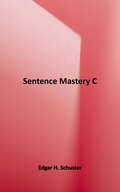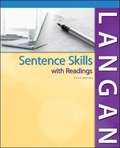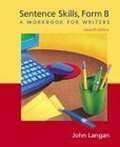- Table View
- List View
Sensibility and Creation: Studies in Twentieth-Century French Poetry (Routledge Revivals)
by Roger CardinalSensibility and Creation (1977) comprises a dozen critical studies by different contributors on a selection of major French poets of the twentieth century. These range from poets of long-established reputation, such as Paul Valéry, Pierre Reverdy, Saint-John Perse and Paul Eluard, to contemporary poets such as Yves Bonnefoy and Jacques Dupin. The guiding theme is that of the characteristic sensibility which informs the creative work of each poet: the way he has of selecting and patterning the elements which make up the world he inhabits and which in a sense he is also creating. In some instances the poetry is examined for its selective textures and shapes, and in others the critical focus is more closely directed to the linguistic and stylistic strategies adopted by the writer.
Sensibility and Female Poetic Tradition, 1780–1860: The Legacy of Charlotte Smith
by Claire KnowlesArguing that the end of the eighteenth-century witnessed the emergence of an important female poetic tradition, Claire Knowles analyzes the poetry of several key women writing between 1780 and 1860. Knowles provides important context by demonstrating the influence of the Della Cruscans in exposing the constructed and performative nature of the trope of sensibility, a revelation that was met with critical hostility by a literary culture that valorised sincerity. This sets the stage for Charlotte Smith, who pioneers an autobiographical approach to poetic production that places increased emphasis on the connection between the poet's physical body and her body of work. Knowles shows the poets Susan Evance, Letitia Elizabeth Landon, and Elizabeth Barrett-Browning advancing Smith's poetic strategy as they seek to elicit a powerful sympathetic response from readers by highlighting a connection between their actual suffering and the production of poetry. From this environment, a specific tradition in female poetry arises that is identifiable in the work of twentieth-century writers like Sylvia Plath and continues to pertain today. Alongside this new understanding of poetic tradition, Knowles provides an innovative account of the central role of women writers to an emergent late eighteenth-century mass literary culture and traces a crucial discursive shift that takes place in poetic production during this period. She argues that the movement away from the passionate discourse of sensibility in the late eighteenth century to the more contained rhetoric of sentimentality in the early nineteenth had an enormous effect, not only on female poets but also on British literary culture as a whole.
Sensibility, Reading and Illustration: Spectacles and Signs in Graffigny, Marivaux and Rousseau
by Ann Lewis"Eighteenth-century sensibilite has always been controversial. In fact, the term itself refers to complex forms of physical and emotional responsiveness, and Lewis's study investigates the fictional exploration of various key problems of sentimental response that were at the heart of eighteenth-century moral, epistemological and aesthetic debates. These are analysed in conjunction with some of the actual (often emotional) responses that the term, its fictions and images have provoked through time, including an indispensable survey of the varying construction of sensibilite as an object of study, and the polemics subtending its definition. The verbal evocation of the visual in the form of 'spectacles' and 'signs' was understood in the eighteenth century as having an especially powerful impact. Lewis provides a new reading of the theme of sensibility by analysing the 'textual images' in three best-selling novels from the mid-century: Graffigny's Lettres d'une Peruvienne, Marivaux's La Vie de Marianne and Rousseau's Julie. The examination of a largely neglected corpus of illustrations, understood as readings of each text, provides striking new evidence of the complexity, thematic richness and duplicity of these spectacles, whose power to provoke different reactions is perhaps their most interesting characteristic."
Sensibility: An Introduction (Routledge Revivals)
by Janet ToddThe cult of sensibility jangled the nerves of Europe in the mid-eighteenth century. It touched all literary genres and brought into prominence those qualities of tenderness, compassion, sympathy and irrational benevolence associated with women by the binary psychology of the time. It privileged spontaneous emotion and found this expressed in the bodily manifestations of tears, fainting fits, flushes and palpitations. Valuing the pure victim, it took as its archetypes the innocent dying Clarissa and the benevolent, suffering man of feeling.In Sensibility, originally published in 1986, Janet Todd charts the growth and decline of sentimental writing as a privileged mode in the eighteenth century. She shows how sentimental writing is riven with contradictions: while it applauds fellowship, it also expresses a yearning for isolation, and while it stresses the ties of friendship and family, it does so at the expense of sexual feeling, which grows menacing and destructive.By the 1770s, as the idea of sensibility was losing ground, ‘sentimentality’ came in as a pejorative term. Janet Todd ends her study of sensibility by detailing the various attacks on the cult, from radicals and conservatives, feminists and Christian moralists; from Coleridge who saw it as unmanning the nation to Jane Austen who considered it an elaborate sham
Sensible Flesh: On Touch in Early Modern Culture
by Elizabeth D. HarveyThis ground-breaking interdisciplinary collection explores the complex, ambiguous, and contradictory sense of touch in early modern culture. If touch is the sense that mediates between the body of the subject and the world, these essays make apparent the frequently disregarded lexicons of tactility that lie behind and beneath early modern discursive constructions of eroticism, knowledge, and art. For the early moderns, touch was the earliest and most fundamental sense. Frequently aligned with bodily pleasure and sensuality, it was suspect; at the same time, it was associated with the authoritative disciplines of science and medicine, and even with religious knowledge and artistic creativity.The unifying impulse of Sensible Flesh is both analytic and recuperative. It attempts to chart the important history of the sense of touch at a pivotal juncture and to understand how tactility has organized knowledge and defined human subjectivity. The contributors examine in theoretically sophisticated ways both the history of the hierarchical ordering of the senses and the philosophical and cultural consequences that derive from it.The essays consider such topics as New World contact, the eroticism of Renaissance architecture, the Enclosure Acts in England, plague, the clitoris and anatomical authority, Pygmalion, and the language of tactility in early modern theater. In exploring the often repudiated or forgotten sense of touch, the essays insistently reveal both the world of sensation that subtends early modern culture and the corporeal foundations of language and subjectivity.
Sensible Life: A Micro-ontology of the Image (Commonalities)
by Emanuele CocciaWe like to imagine ourselves as rational beings who think and speak, yet to live means first and foremost to look, taste, feel, or smell the world around us. But sensibility is not just a faculty: We are sensible objects both to ourselves and to others, and our life is through and through a sensible life.This book, now translated into five languages, rehabilitates sensible existence from its marginalization at the hands of modern philosophy, theology, and politics. Coccia begins by defining the ontological status of images. Not just an internal modification of our consciousness, an image has an intermediate ontological status that differs from that of objects or subjects. The book’s second part explores our interactions with images in dream, fashion, and biological facts like growth and generation. Our life, Coccia argues, is the life of images.
Sensitive Negotiations: Indigenous Diplomacy and British Romantic Poetry (SUNY series, Studies in the Long Nineteenth Century)
by Nikki HessellThroughout the nineteenth and early twentieth centuries, Indigenous peoples in North America and the Pacific engaged with the latest and most fashionable British Romantic poetry as part of transcontinental and transoceanic cross-cultural negotiations about sovereignty, treaty rights, and land claims. In Sensitive Negotiations, Nikki Hessell uses examples from North America, Africa, and the Pacific to show how these Indigenous figures quoted lines from famous poets like Lord Byron and Felicia Hemans to build sympathy and community with their audience. Hessell makes new connections by setting aside European-derived genre barriers to bring literary studies to bear on the study of diplomacy and scholarship from diplomatic history and Indigenous studies to bear on literary criticism. By connecting British Romantic poetry with Indigenous diplomatic texts, artefacts, and rituals, Hessell reimagines poetry as diplomatic and diplomacy as poetic.
Sensitive Pasts: Questioning Heritage in Education (Making Sense of History #27)
by Maria Grever Carla Van Boxtel Stephan KleinHeritage, as an area of research and learning, often deals with difficult historical questions, due to the strong emotions and political commitments that are often at stake. In this, it poses particular challenges for teachers, museum educators and the publics they serve. Guided by a shared focus on these “sensitive pasts,” the contributors to this volume draw on new theoretical and empirical research to provide valuable insights into heritage pedagogy. Together they demonstrate the potential of heritage as a historical-educational domain that transcends myopic patriotism, parochialism and simplistic relativism, helping to enhance critical and sophisticated historical thinking.
Sensitive Reading: The Pleasures of South Asian Literature in Translation
by Yigal Bronner and Charles HalliseyA free open access ebook is available upon publication. Learn more at www.luminosoa.org. What are the pleasures of reading translations of South Asian literature and what does it take to enjoy them? This volume explores these questions by bringing together a whole set of new translations by David Shulman, noted scholar of South Asia. The translated selections come from a variety of Indian languages, genres, and periods, from classical to current. They are accompanied by short essays especially written to help readers engage and enjoy them. Some of these essays provide background to enhance any reading of the translation while others model how to expand appreciation in broader and comparative ways. Taken together, the translations and the accompanying essays form an essential guide for people interested in literature and art from South Asia.
Sensitive Witnesses: Feminist Materialism in the British Enlightenment
by Kristin M. GirtenKristin M. Girten tells a new story of feminist knowledge-making in the Enlightenment era by exploring the British female philosophers who asserted their authority through the celebration of profoundly embodied observations, experiences, and experiments. This book explores the feminist materialist practice of sensitive witnessing, establishing an alternate history of the emergence of the scientific method in the eighteenth century. Francis Bacon and other male natural philosophers regularly downplayed the embodied nature of their observations. They presented themselves as modest witnesses, detached from their environment and entitled to the domination and exploitation of it. In contrast, the author-philosophers that Girten takes up asserted themselves as intimately entangled with matter—boldly embracing their perceived close association with the material world as women. Girten shows how Lucy Hutchinson, Margaret Cavendish, Aphra Behn, Eliza Haywood, and Charlotte Smith took inspiration from materialist principles to challenge widely accepted "modest" conventions for practicing and communicating philosophy. Forerunners of the feminist materialism of today, these thinkers recognized the kinship of human and nonhuman nature and suggested a more accessible, inclusive version of science. Girten persuasively argues that our understanding of Enlightenment thought must take into account these sensitive witnesses' visions of an alternative scientific method informed by profound closeness with the natural world.
Sensory Experience and the Metropolis on the Jacobean Stage (Studies In Performance And Early Modern Drama Ser.)
by Hristomir A. StanevAt the turn of the seventeenth century, Hristomir Stanev argues, ideas about the senses became part of a dramatic and literary tradition in England, concerned with the impact of metropolitan culture. Drawing upon an archive of early modern dramatic and prose writings, and on recent interdisciplinary studies of sensory perception, Stanev here investigates representations of the five senses in Jacobean plays in relationship to metropolitan environments. He traces the significance of under-examined concerns about urban life that emerge in micro-histories of performance and engage the (in)voluntary and sometimes pre-rational participation of the five senses. With a dominant focus on sensation, he argues further for drama’s particular place in expanding the field of social perception around otherwise less tractable urban phenomena, such as suburban formation, environmental and noise pollution, epidemic disease, and the impact of built-in city space. The study focuses on ideas about the senses on stage but also, to the extent possible, explores surviving accounts of the sensory nature of playhouses. The chapters progress from the lower order of the senses (taste and smell) to the higher (hearing and vision) before considering the anomalous sense of touch in Platonic terms. The plays considered include five city comedies, a romance, and two historical tragedies; playwrights whose work is covered include Shakespeare, Jonson, Webster, Fletcher, Dekker, and Middleton. Ultimately, Stanev highlights the instrumental role of sensory flux and instability in recognizing the uneasy manner in which the London writers, and perhaps many of their contemporaries, approached the rapidly evolving metropolitan environment during the reign of King James I.
Sensory Experiments: Psychophysics, Race, and the Aesthetics of Feeling
by Erica FretwellIn Sensory Experiments, Erica Fretwell excavates the nineteenth-century science of psychophysics and its theorizations of sensation to examine the cultural and aesthetic landscape of feeling in nineteenth-century America. Fretwell demonstrates how psychophysics—a scientific movement originating in Germany and dedicated to the empirical study of sensory experience—shifted the understandings of feeling from the epistemology of sentiment to the phenomenological terrain of lived experience. Through analyses of medical case studies, spirit photographs, perfumes, music theory, recipes, and the work of canonical figures ranging from Kate Chopin and Pauline Hopkins to James Weldon Johnson and Emily Dickinson, Fretwell outlines how the five senses became important elements in the biopolitical work of constructing human difference along the lines of race, gender, and ability. In its entanglement with social difference, psychophysics contributed to the racialization of aesthetics while sketching out possibilities for alternate modes of being over and against the figure of the bourgeois liberal individual. Although psychophysics has largely been forgotten, Fretwell demonstrates that its importance to shaping social order through scientific notions of sensation is central to contemporary theories of new materialism, posthumanism, aesthetics, and affect theory.
Sensory Integration: A Guide for Preschool Teachers
by Rebecca Isbell Christy IsbellDo you have a child in your early childhood classroom who:*Climbs on top of furniture and jumps off? *Covers his ears when children are singing? *Refuses to touch clay, paint, or sand? *Often falls down and skins her knees? *Refuses to play on outdoor playground equipment?If so, it is possible the child is having sensory processing problems. How can you help children with these problems so they can enjoy learning and grow in positive ways? Sensory Integration helps you identify children who have difficulties with sensory processing, and it offers simple, easy-to-use solutions to support the sensory needs of young children in the preschool classroom. Easy-to-implement solutions include adaptations and activities for children with different types of Sensory Processing Disorder. This book has a bonus chapter with instructions for creating low-cost items to help children with sensory issues.Chapters cover concepts such as:*Explaining Sensory Integration and Sensory Processing Disorder*Defining sensory avoiders, seekers, and under-responders*Designing the environment to support the sensory development of all children*Helping preschoolers with sensory processing problems*Providing practical solutions to meet the needs of individual children during daily routines*Building and creating low-cost items such as a tire swing, sand pillow, and incline board to give children opportunities to get the sensory input they need
Sensory Perceptions in Language, Embodiment and Epistemology (Studies in Applied Philosophy, Epistemology and Rational Ethics #42)
by Annalisa Baicchi Rémi Digonnet Jodi L. SandfordThe book illustrates how the human ability to adapt to the environment and interact with it can explain our linguistic representation of the world as constrained by our bodies and sensory perception. The different chapters discuss philosophical, scientific, and linguistic perspectives on embodiment and body perception, highlighting the core mechanisms humans employ to acquire knowledge of reality. These processes are based on sensory experience and interaction through communication.
Sensory Writing for Stage and Screen: An Etude-Based Process of Exploration
by Michael WrightThrough a series of systematic explorations across a wide range of scenarios, Sensory Writing for Stage and Screen offers script writers exercises for attending to their own sensory experiences as a means to exploring the sensory experiences—and worlds—of the characters they create.
Sensuality in Human Living: The Cultural Psychology of Affect (SpringerBriefs in Psychology)
by Jaan ValsinerThis book is a theoretical account for general psychology of how human beings meaningfully relate with their bodies-- from the basic physiological processes upwards to the highest psychological functions of religiosity, ethical reasoning, and devotional practices. It unites art and science into a new theory of affective synthesis that human minds are constantly involved in their everyday life worlds. Provides a new theory of aesthetic synthesis;Demonstrates the links between art and science;Provides a new understanding of the role of affect in human cognition.
Sentence Combining: A Composing Book
by William StrongThis highly regarded text helps developmental writing students strengthen their writing skills and understand some of the stylistic choices available to them in written English. Simply put, sentence combining involves putting short, choppy sentences together to make more interesting, readable ones. In the process, students learn the importance of sentence variety in improving syntax. Students are able to explore a variety of ways to say something in writing and learn that there is not a single "right" way to express their point. SENTENCE COMBINING features an accessible and humorous writing style, along with innovative and thoroughly tested exercises which not only allow students to flex their creative muscles, but also offer them insights into current topics and issues. New to this edition are two end-of-text appendices on sentence combining, the writing process and sentence and paragraph strategies.
Sentence Composing For College: A Worktext On Sentence Variety And Maturity (Sentence Composing)
by Don KillgallonWith the original publication of his sentence composing series, Don Killgallon changed the way thousands of high school English teachers and their students look at language, literature, and writing by focusing on the sentence. In this expanded series, Killgallon presents the same proven methodology but offers all-new writing exercises for middle school, high school, and college students. <p><p> Unlike traditional grammar books that emphasize sentence analysis, these worktexts asks students to imitate the sentence styles of professional writers, making the sentence composing process enjoyable and challenging. Killgallon teaches subliminally, nontechnically - the ways real writers compose their sentences, the ways students subsequently intuit within their own writing. <p> Designed to produce sentence maturity and variety, the worktexts offer extensive practice in four sentence-manipulating techniques: sentence unscrambling, sentence imitating, sentence combining, and sentence expanding. It's demonstrably true that Sentence Composing can work anywhere--in any school, with any student.
Sentence Comprehension as a Cognitive Process: A Computational Approach
by Shravan Vasishth Felix EngelmannSentence comprehension - the way we process and understand spoken and written language - is a central and important area of research within psycholinguistics. This book explores the contribution of computational linguistics to the field, showing how computational models of sentence processing can help scientists in their investigation of human cognitive processes. It presents the leading computational model of retrieval processes in sentence processing, the Lewis and Vasishth cue-based retrieval mode, and develops a principled methodology for parameter estimation and model comparison/evaluation using benchmark data, to enable researchers to test their own models of retrieval against the present model. It also provides readers with an overview of the last 20 years of research on the topic of retrieval processes in sentence comprehension, along with source code that allows researchers to extend the model and carry out new research. Comprehensive in its scope, this book is essential reading for researchers in cognitive science.
Sentence Mastery - Book B
by Edgar H. SchusterA Sentence-Combining Program Integrated with Practice in Basic Grammar, Usage, and Mechanics
Sentence Mastery - Book C, Second Edition
by Edgar H. SchusterThis book is for you. Its purpose is to help make you a better writer. It is based on an old idea--that one can improve a skill by practice. You know that batters improve by practicing hitting. Piano players improve by practicing the piano. Carpenters improve by practicing their trade. There is every reason to believe that you will improve as a writer by writing. Yet it is not certain that you will improve only by writing. Student writers who do not know certain fundamentals may merely repeat their errors. This book offers carefully controlled practice. If you can understand a few basic clues, you will not merely write sentences, you will write good sentences. By the time you have finished this book, you will have written hundreds of good sentences. You will be well on your way toward sentence mastery. In addition to writing good sentences, you will also gain practice in writing correct forms of words. For example, you will practice writing write and right, past and passed, to mention only two of the twenty items in this book. In the first problem or two in early lessons, we call attention to these troublesome words by printing them in boldfaced italics. Boldfaced italics look like this: write, right; past, passed. In later lessons you will receive much additional practice writing such troublesome words. Some people naturally work faster than others. If you are one of these fast workers, you will find extra practice for each lesson at the back of the book, beginning on page 129. If you finish any lesson before your classmates, turn to the proper page near the end of the book and you will find more sentences to do. This book may also help you to improve your punctuation, capitalization, spelling, and even your handwriting.
Sentence Skills with Readings (Fifth Edition)
by Paul Langan John LanganGrounded in John Langan’s Four Bases – unity, coherence, sentence skills, and support – Sentence Skills with Readings employs a unique personalized learning plan to address student deficits in grammar and mechanics and to free instructional time for activities emphasizing writing process and critical thinking. Sentence Skills with Readings offers students a practical guide to becoming better writers. This best-selling sentence-level text returns in a new edition highlighting the essential grammar, mechanics, punctuation, and usage skills needed for clear, college-level writing.
Sentence Skills: A Workbook for Writers, Form B
by John LanganThis best-selling sentence-level worktext by John Langan continues to help students master the essential grammar, mechanics, punctuation, and usage skills needed for clear, thoughtful writing. The seventh edition of Sentence Skills, Form B features a greater emphasis on prewriting and revision, a new chapter for non-native speakers, and much more!.
Sentence Strategies for Multilingual Learners: Advancing Academic Literacy through Combinations
by Nell Scharff Panero Joanna YipThis book presents Combinations as a set of high-yield instructional strategies for advancing academic literacy for multilingual learners and all students. It discusses the strategies themselves as well as how they work to advance content and language learning simultaneously, across the grades and content areas. The book is particularly beneficial for all teachers working with linguistically and culturally diverse learners to accelerate their language and content learning. Utilizing these strategies will not only greatly improve students’ writing but also supports their critical thinking, content area reading and language comprehension skills. This book argues for utilizing Combinations with Strategic Inquiry, presenting evidence of how each amplifies the impact of the other, and how together they address many of the challenges to learning new and counter-cultural methods and to establishing school and district cultures in support of multilingual learners’ success. This book is a great resource for classroom teachers, literacy coaches and school and district administrators who want to support multilingual learners and all students to thrive.
Sentence Strategies for Multilingual Learners: Advancing Academic Literacy through Combinations
by Nell Scharff Panero Joanna YipThis book presents Combinations as a set of high-yield instructional strategies for advancing academic literacy for multilingual learners and all students. It discusses the strategies themselves as well as how they work to advance content and language learning simultaneously, across the grades and content areas.The book is particularly beneficial for all teachers working with linguistically and culturally diverse learners to accelerate their language and content learning. Utilizing these strategies will not only greatly improve students’ writing but also supports their critical thinking, content area reading and language comprehension skills. This book argues for utilizing Combinations with Strategic Inquiry, presenting evidence of how each amplifies the impact of the other, and how together they address many of the challenges to learning new and counter-cultural methods and to establishing school and district cultures in support of multilingual learners’ success.This book is a great resource for classroom teachers, literacy coaches and school and district administrators who want to support multilingual learners and all students to thrive.
